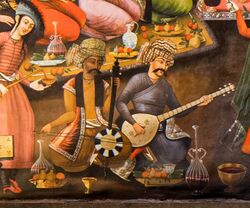Engineering:Shashtar
From HandWiki
 6-stringed Şeştar shown in mural in Chehel Sotoun. | |
| String instrument | |
|---|---|
| Other names | Sheshtar, Shashtay, Şeştar, Sheshtay |
| Classification | String instrument |
| Hornbostel–Sachs classification | (Composite chordophone) |
| Developed | Ancient Persia or Central Asia |
The Shashtar, Sheshtar or Shashtay (probably from Persian Şaş-tar or Şeş-tar, ششتار or ششتار, lit. six-string', 'having six strings) is a stringed musical instrument of the lute family. It was mentioned historically by Evliya Çelebi and Abd al-Qadir Maraghi.[1][2] It is or was played in Iran/Persia, Afghanistan, Azerbaijan and elsewhere.[3][4][5][6][7] It may have been developed during the Safavid dynasty from the tambur.[8][9] Like the tambur, it has a floating bridge and a wooden soundboard (not skin like the rubab etc). The 6 gut strings were in 3 double courses, and thus it may be a forerunner of the Tar.[10][11]
References
- ↑ Chabrier, Jean-Claude (2008). "ʿŪd". Encyclopedia of Islam: 534. "The ḳabūs (al-Ḥid̲j̲āz), ḳabbūṣ (ʿUmān), ḳanbūṣ (Ḥaḍramawt), ḳupūz or ḳūpūz (Turkey) is a very old instrument. Evliyā Čelebi [q.v.] says that the ḳūpūz was invented by a vizier of Meḥemmed II (d. 886/1481) named Aḥmed Pas̲h̲a Hersek Og̲h̲lu. He describes it as being a hollow instrument, smaller than the shashtār, and mounted with three strings (Travels, i/2, 235). On the other hand, Ibn G̲h̲aybī says that the ḳūpūz rūmī had five double strings. The instrument is no longer used by the Turks, although it has survived under the name of kobza, koboz, in Poland, Russia, and the Balkans, but here it is the lute proper and not a barbaṭ type"
- ↑ "5.4 - Piecing Together History, String By String - The Reconstruction of Azerbaijan's Medieval Instruments". Azer.com. http://azer.com/aiweb/categories/magazine/54_folder/54_articles/54_instruments.html. Retrieved 2020-01-19.
- ↑ "Pharaonic, tribal style, middle eastern, rai and arabic-oriental bellydance music, free mp3". Belly-dance.org. http://belly-dance.org/music.php. Retrieved 2020-01-19.
- ↑ Menù. "Welcome". www.salvoraodj.it. http://www.salvoraodj.it/. Retrieved 2020-01-19.
- ↑ Rudyard Kipling (2018-03-12). "Traditional Instruments Used In Afghanistan". Afghan-web.com. https://www.afghan-web.com/culture/musical-instruments/. Retrieved 2020-01-19.
- ↑ "Ancient Musical Instruments of Afghanistan". AfghanMagazine. 1929-01-14. https://afghanmagazine.com/post/186134562294/ancient-musical-instruments-of-afghanistan. Retrieved 2020-01-19.
- ↑ "Data". irs-az.com. http://irs-az.com/new/pdf/201109/1316780982469887428.pdf. Retrieved 2020-01-19.
- ↑ "Iranian Music". The Tour Expert. https://www.thetourexpert.com/countries/iran-information-guide/iranian-music. Retrieved 2020-01-19.
- ↑ "Musical Instruments of Azerbaijan – Texas Azerbaijanis | News Blog". Texasazerbaijanis.com. https://www.texasazerbaijanis.com/azerbaijan/music-of-azerbaijan/musical-instruments-azerbaijan/. Retrieved 2020-01-19.
- ↑ http://files.preslib.az/projects/azerbaijan/eng/gl5.pdf [bare URL PDF]
- ↑ https://shahnameh.netlify.com/shashtar.htm The Shahnameh Guide To The Lutes Of Central Asia
 |
